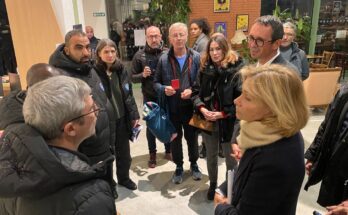It will have 382 rooms, a 2,500 square meter auditorium, underground parking, a restaurant with a panoramic point and a height of 144 metres. Details of the future Torre del Puerto, Malaga’s most controversial building in a past decade full of urban controversy, were presented to the press on Monday. This was done by the promoters, the Qatari fund Al Alfia together with the Hesperia hotel group, as well as the studio of the prestigious architect David Chipperfield, who took care of the design only a year ago and neither the mayor, Francisco de la Torre, nor the president of the Port Authority, Carlos Rubio, were present at the presentation. The initiative is affected by the two jurisdictional appeals presented against it and the decision taken by the Government in the Council of Ministers, still undated. Meanwhile, a part of Malaga society shows its rejection of the construction due to its impact on the landscape, as also warned by the International Council of Monuments and Sites (ICOMOS), which is a consultant to UNESCO.
The skyscraper will be built at the end of the Levante dock, on land adjacent to the cruise ship station which required the modification of the urban planning regulations of the Special Port Plan to become reality. Chipperfield designed a building 144 meters high, 59 meters wide and 19 meters wide, inspired by Mediterranean architecture and designed according to sustainability criteria. The establishment – which has a 50-year concession – will be a five-star Grand Luxury and, although it is promoted by Hesperia, will be managed by another company.
The promoters explained that they are negotiating with three international brands for this, without naming names. Yes, they have specified that their electricity will be 100% renewable and that their operation will not emit emissions into the atmosphere “because the use of fossil fuels will be zero”, according to Jorge Mañas, founding partner of the architecture firm TAG Partners, which coordinates. “It is a project without fanfare or excessive expenses that does not end up occupying a space, it ends up giving it back to the city. It fits naturally into the transformation process that Malaga has followed in the last 20 years”, underlined Jordi Ferrer, executive director of the Hesperia Investment Group. “It’s friendly, it’s consistent and it’s on the scale of the city,” Ferrer added.
The action involves, at its feet, the construction of various public spaces, such as a square that aims to host recreational, gastronomic and cultural activities. And he also wants to build an ambitious landscaped avenue with a viewpoint that will run 1.3 kilometers along the entire pier from the La Farola area, in the La Malagueta neighborhood. It is precisely this area that is intended to be used to justify the general interest of the proposal before the Council of Ministers. “The project is defended because it returns those 54,000 square meters to Malaga. A logistical infrastructure like the current one is not equivalent to transforming the entire dam for the city,” said Rodrigo Antón, director of the Santiago de Compostela office of David Chipperfield’s firm. The initiative, as a whole, has an approximate budget of 200 million euros, although the promoters are confident in European funds and the support of the administrations to finance the boulevard in the port area.
“Irreversible” consequences.
From the studio they claim that the building’s design is conceived as “a light and abstract piece that appears on the horizon with a contemporary and elegant presence”. It is precisely its impact on the landscape that most pushed the citizens of Malaga to raise their voices against an aspiration that has been talked about in Malaga since 2001. Then, the Association for the Study and Integral Development of Malaga, which brought together businessmen and professionals and to which the mayor Francisco de la Torre was linked, invited Frank Gehry to Malaga. They wanted to propose to him to build a building on the Levante dock, but he ran away terrified because he thought he was coming to get hired when in reality the idea was still very green and, furthermore, the Port Authority reminded him that the project, if it had been developed, would have to be awarded with a public tender and not by hand.
This step was only taken in 2015, but instead of the traditional system a competition procedure was opted for: the port of Malaga declared that there was already someone interested in occupying the dock, the Qatari fund Al Alfia, which already had the project of a 136 meter high building designed by the architect José Seguí, and opened a short period for other competitors to apply. Only a second proposal appeared, which did not even meet some of the requirements of the process. Eventually he was assigned to Al Alfia, who had reached an agreement with Hesperia. It was necessary, however, to modify the Special Plan of the port area so that the lot on which the property was planned would multiply its buildability by seven: it would go from a limit of 6,000 to 45,000 square metres. The trial lasted seven years: it was approved by the Malaga City Council in 2022 after having 1,100 accusations against it.
Before that date numerous opposing voices had emerged, such as the 250 cultural representatives who signed a manifesto asking that the building not be raised. Or the initiative that collected more than 17 thousand signatures on Change.org. One of the most relevant is that of the ICOMOS organization, which asked in 2018 that the construction be abandoned because it would have had “irreversible” consequences on the city and that its dimensions would have transformed the landscape, as well as impacting La Farola, a property declared an Asset of Cultural Interest. “No one in Florence, for example, would think such a thing,” said Víctor Fernández, professor at the Higher Technical School of Architecture at the University of Seville and one of the authors of the UNESCO advisory body document.
After that date, the Defendamos Nuestro Horizonte platform – founded in 2017 – and the Academy of Fine Arts of San Telmo presented separate jurisdictional appeals focused precisely on the modification of elements certified by the Municipality. “We believe that there are some non-compliances with legislation regarding historical heritage, urban planning, environmental assessment and port regulation itself,” says Matías Mérida, one of the managers of the platform and professor of Geography at the University of Malaga, who insists that they are not against one project or another of the hotel, but rather its “exaggerated and in a completely inappropriate place” volume. This is exactly what they defended from the Official College of Architects of Malaga, where they recall that they do not reject the building, but rather the chosen place.
These judicial resources are crucial for the work of Chipperfield, the 2023 Pritzker Prize winner who received the commission in 2024, to become a reality (which prompted Seguí to decide to retire). Nobody knows when the judicial resolution will arrive, but Minister Óscar Puente has already warned that he will wait to take the initiative at the Council of Ministers. This must authorize hotel use in a port area, which is not foreseen by the legislation. It is expected to last until 2026, but the significance of the government’s decision is unknown because both the PSOE and Sumar reject it, although the socialists initially supported the idea. Of course, the promoters hope to get permits and even start construction next year to make it a reality in 2029.



